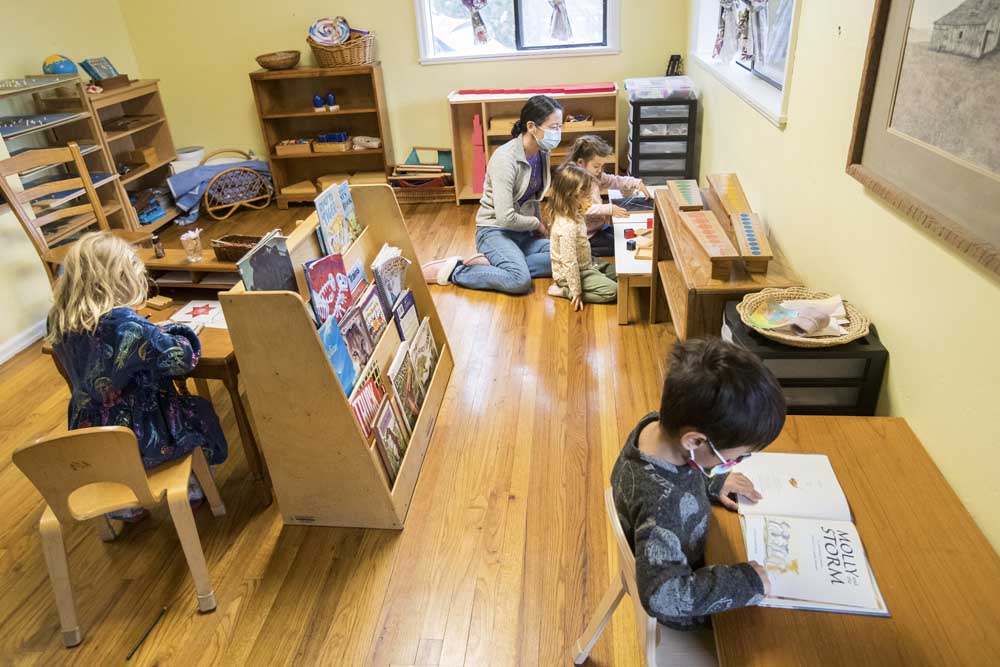Child care business model forces thin margins for providers
Published 5:00 am Sunday, February 6, 2022

- Richardson, owner and operator of Sprouts Montessori in Bend, supervises a pair of students as they work on puzzles on Friday.
Sprouts Montessori owner Sharon Richardson would expand her daycare business further if she could.
“I’m really passionate about Montessori education, especially at the infant and toddler level,” Richardson told The Bulletin.
Trending
“When I’m doing my work, it’s not only for the families and not only as a business for me, it’s because I really care about the work that I do, and Montessori education is a gift to society.”
Soon after she moved to Bend in 2019, the job Richardson had lined up was eliminated. So she pivoted, using the materials she’d brought with her from the daycare she used to run on California’s north coast to open Sprouts, a certified family daycare. She did all the renovations on what she called a “super run down building” herself.
In a region experts call a “child care desert,” the business owners who provide care struggle to make ends meet, working unsustainably long hours in an economy slammed by a lack of available workers while parents scramble to find care and the community at large pays the price.
While her business had to change significantly with COVID-19 precautions, Richardson weathered the pandemic with the help of child care business grants, even opening a second location on Bend’s east side.
The new location, which opened in August 2021, would cater to babies, infants and toddlers, a complement to the preschool-aged kids served by her other location, Richardson hoped.
If there’s one thing that’s easy about Richardson’s business, it’s predicting the new spaces would fill quickly: The new facility’s 15 slots were full the same-day registration opened, and Sprouts now has a waitlist with over 100 children on it, some who aren’t born yet.
Trending
Not as predictable was finding employees, Richardson did not anticipate the exceptionally tight labor market in recent months and how it would hamstring her ability to help the families seeking care.
When Richardson published job ads for an employee at her first location, she got about 50 applications. But the ads she put out for employees at her new location were met with far fewer applicants, most of them less qualified, and almost none already fingerprinted and registered by state regulators.
“Now my pool of applicants is nothing. There’s almost no one applying,” Richardson said.
Sprouts’ inability to fully staff its locations forced Richardson to reduce the business’ capacity. Now, the preschool location can serve 12 of the 15 kids it is designed for, and the infant and child location can serve just eight of the 15 Richardson planned for.
With such low staffing levels and the amount of time the youngest babies need to be held by caregivers, Richardson and her employees took a physical toll as they cared for the youngest children.
Quickly after opening her new location, Richardson scuttled plans to care for the babies altogether.
“That really was a hard thing to tell parents, that I couldn’t take care of their babies anymore. They were so brave to go back to work,” she said. “It’s a big decision, and they made the decision, and they felt so good about who they left their babies with, then they had to end care.”
It’s not a unique problem: Central Oregon, as well as most communities statewide, face an even more intense shortage of child care for the youngest children. State requirements mandate a lower employee-to-child ratio when caring for infants to 2-year-olds than 3- to 5-year-olds.
That means child care businesses have to hire more employees to care for fewer children if they want to enroll babies, according to Karen Prow, the director of child care resources for NeighborImpact, which assists providers in the region.
“Infants and toddlers are the most expensive children to provide care for, because of that ratio,” Prow said. “Why are we in an infant and toddler crisis? Well, guess what? It actually costs more.”
That’s translated into even fewer available care slots for the youngest children. Statewide, there were enough slots for 14% of the state’s kids under 2 — before the pandemic. The figure was 18% for Jefferson County, 12% for Deschutes County and just 6% for Crook County.
Richardson would expand her business to include centers for infants and toddlers, as well as learning support for school-aged kids – if she had the land and financial resources for the right facilities, as well as the finance and permitting knowledge to pull off such an expansion with complex building regulations and facility requirements.
“I cannot really expand because I’m also a single mother, and I don’t have a whole bunch of resources despite my background,” Richardson said. “To try to go from home daycare to try to be a center in Bend is nearly impossible for a person like me.”
While Richardson still holds hope for a possible expansion if hiring high-quality staff gets easier, the work takes a toll on her. She loses a lot of time at home with her own two kids as she works 10-hour days and often stays late to clean, since her profit margins are too tight to afford janitorial services.
At times, balancing the financials of her business with her desire for a normal, eight-hour work schedule, make Richardson take a hard look at whether she can continue doing the work she loves.
“I do sometimes wonder how long I can go. If the grant money runs out, and I’m not able to increase enrollment, I don’t think I’m going to be able to make ends meet,” Richardson said. “Sometimes I do wonder if I should just go back to looking for a job — but I don’t want to, because I love my work so much.”
A broken business model, or no business model at all?
A major driver of the shortage of care is the industry’s business model, where a high share of expenses go to staff and income is derived mostly from parents means providers must balance raising the rates they charge families and keeping employee wages stagnant.
The business model also means the early care and education industry has a high attrition rate for employees who move on to higher-paying work.
Today’s coverage of Central Oregon’s child care crisis is the the latest in a series from The Bulletin and ongoing partnership with the City Club of Central Oregon. Next week, we turn to solutions, profiling the people, organizations and models that are finding ways to respond.
You can join the conversation as The Bulletin partners with the City Club for a community forum on February 17. Bulletin Special Projects Reporter Zack Demars will moderate a panel of local child care experts titled “Cracking Open the Childcare Crisis” at noon in-person and streaming online. More information and forum registration is available online at bendbulletin.us/childcareforum.
After the forum, The Bulletin will convene a Solutions Workshop with local leaders to move the needle on solutions to the crisis in our community.
“It used to be that we did have a lot of people subsidizing the field of early care and education by taking a lower wage,” Prow said. “There comes a place where that’s just not realistic, and there are so many other options out there for people to go and make a living wage.”
That leads to the industry’s high turnover rate. A quarter of the state’s 2018 higher education workforce left the industry by the next year, according to an Oregon State University study.
There is hope on the horizon: Many individuals, nonprofits and other organizations in Central Oregon are making headway in tackling each aspect of the region’s child care shortage, from its broken business models and low-profit margins to its high-turnover workforce and high barriers to entry.
Some experts point to the region as a breeding ground for possible models other regions across the state might copy. Megan Pratt, who leads OSU’s child care research efforts, says Central Oregon’s network of providers and nonprofits gives the region an advantage in responding to the crisis.
“What is also clear is that a one-sized-fits-all solution is not going to work, and what seems to be working is this mix of state investment with this community understanding of what the local needs are and what the dynamics are,” Pratt said. “Because what’s needed in Bend is going to be different than what’s needed in Prineville.”








